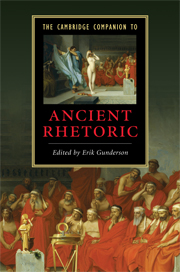Book contents
- Frontmatter
- Introduction
- Part 1 An archaeology of rhetoric
- Part II The field of language
- Part III The practice of rhetoric
- Part IV Epilogoues
- 14 Rhetorical practice and performance in early Christianity
- 15 Rediscoveries of classical rhetoric
- 16 The runaround: a volume retrospect on ancient rhetorics
- Appendix 1: Rhetorical terms
- Appendix 2: Authors and prominent individuals
- References
- Index of passages
- Index of subjects
- Series list
16 - The runaround: a volume retrospect on ancient rhetorics
from Part IV - Epilogoues
Published online by Cambridge University Press: 28 January 2010
- Frontmatter
- Introduction
- Part 1 An archaeology of rhetoric
- Part II The field of language
- Part III The practice of rhetoric
- Part IV Epilogoues
- 14 Rhetorical practice and performance in early Christianity
- 15 Rediscoveries of classical rhetoric
- 16 The runaround: a volume retrospect on ancient rhetorics
- Appendix 1: Rhetorical terms
- Appendix 2: Authors and prominent individuals
- References
- Index of passages
- Index of subjects
- Series list
Summary
It’s too bad that the people who know how to ruin the country are busy teaching school.
(Naff bumper sticker)Performance
Accustomed to public speaking as all our companions are, they have none of them told us if they trained and how, pebbles in Demosthenic cheeks above the roar of the surf, or mantras intoned at some imaginary Archias’ feet. They have indeed regaled us with precious little of the mythology surrounding the star speakers of antiquity (with the necessary exception of Penner and Vander Stichele’s Jesus, Paul, and co.). And they have suppressed detail on their own investment in rhetoric, ancient or modern (with the exception of Heath’s adversion to his own hands-on teaching of ancient rhetoric in school). But in performative terms, the rest of these scholar essays practiced house-style exegetics even while preaching the intrication of rhetoric with form-content fusion and fission – whereas Batstone dared enter into the spirit of things, casting his dramas of genre-indifferent rhetorical performativity in the outward shell of a scriptwriter’s formatting, as he cooks up a narrative leading us from staged scenes of worlds talked into existence and on to settings for world-shattering debate in and as historiography, then out towards a finale vista of entire cultures manned by selves realized as roles; and Gunderson was (acting out) toying with his reanimation of Quintilian’s project as the realization of its own training by mounting his account as a fresh realisation of Quintilian’s training - with the didactic difference that the essay runs us lap after lap through explicitation of his quasi-oration’s ticking the grand manual’s boxes.
- Type
- Chapter
- Information
- The Cambridge Companion to Ancient Rhetoric , pp. 278 - 290Publisher: Cambridge University PressPrint publication year: 2009

